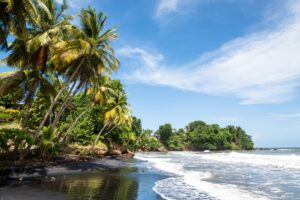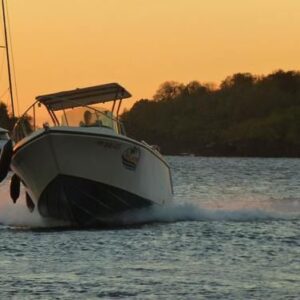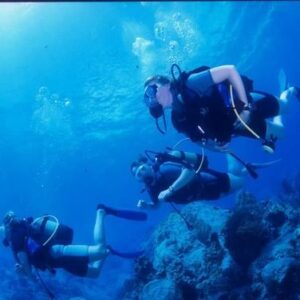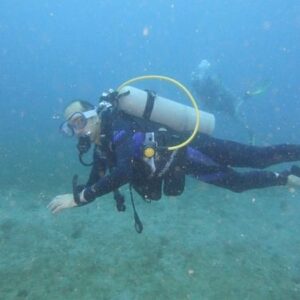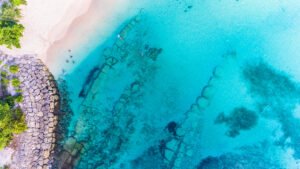Guadeloupe is a French region located in the Eastern Caribbean between the countries of Antigua, Barbuda, and Dominica. Guadeloupe presents divers with various unique and beautiful dives. Guadeloupe is composed of six inhabited islands, six uninhabited islands and several islets and rocky outcrops. The islands have an extensive network of coral reefs surrounding them with volcanic subsea terrain. The volcanic topography has resulted in rich soil and lush vegetation. Divers will discover different substrates between dives in Grade Terre, Basse Terre, Marie Galante, La Desrade and Les Saintes and an underwater world of meadows, wrecks, caves, arches, and drop-offs. Land adventures with awe-inspiring landscapes await topside which includes a volcano, tropical forests, sugar cane fields, beaches, waterfalls, and coves. The combination of natural beauty with French flair only adds to the appeal of Guadeloupe’s diving experience.
GETTING THERE
Air: Direct flights through New York (JFK) with JetBlue and from Miami (MIA) with American Airlines and Air France. Visitors will fly into Pointe-a-Pitre (PTP), Guadeloupe.
GETTING AROUND
All the major vehicle rental companies are represented in the Guadeloupe Islands.
GOOD TO KNOW
Country: France
Time Zone: UTC-4
Primary Language: French is the official language. Locals speak Creole.
Currency: EUR
Cell Phone Service: Roaming charges apply.
Voltage: 220V Plugs C, D, E
Passport and Visa: US citizens must have a valid Passport and must be valid for 6 months beyond date of entry and 1 page required for entry stamps.
Hurricane Details: Early June-Late November
DIVE CONDITIONS
Water Temperature: 79 to 86 degrees
Water Visibility: 60-100 feet
When to Go: February to April
Diving Difficulty: Beginner-Advanced
TOP DIVE SITES IN GUADELOUPE
Guadeloupe caters to the diving enthusiast! Listed are some of the very best that Guadeloupe can offer divers:
- La Grotte Aux Baracudas is home to massive schools of barracudas and a gorgeous blue cave. Due to its depths, this is an advanced dive ideal for experienced divers. As a favorite dive spot of Jacques Cousteau, divers can expect plenty of barracudas, spiny lobsters and other crabs hiding in the cracks in the cave. There are also starfish, moray eels, frogfish, reef fish and rays.
- L’Augustine Fresnel is a 173-foot lighthouse ship that was assigned to the center of Pointe a Pintre during the early 1990s to keep the area safe during the maintenance of the buoys in Antilla, and Guyana. When completed, it was moved and intentionally sunk in Guadeloupe in 2003 at a depth of 82 feet for divers and scientific dives. Hurricane DEAN pushed the wreck to its now depth of 108 feet. It is a spectacular artificial reef and an impressive site for advanced divers. The wreck has plenty to see including groupers, tunas, barracudas, and stingrays. Hundreds of swallowtail perch will swarm around divers making this an unforgettable dive.
- Point Lezarde is a small patch of dry land rising from the water and easily spotted. The drop off is thrilling and impressive for advanced divers. This dive offers many sponges and a gradual descent to 130 feet where the drop off is drastic. The uniqueness of this dive is the hot springs bubbling from the seabed and the marine life that can be found here. Divers will spot punctuated char, octopus, barracuda, groupers, fire fish volitans and a trevally. There are also frequent sightings of dolphins and turtles at this site.
- Sec Pate (Les Saintes) is located around the underwater pinnacles in the channel off Les Saintes. The underwater pinnacles resembles a row of witches’ hats and attract a variety of marine creatures. Due to the strong current, this dive is best suited for experienced divers. There is a large variety of healthy coral growing on the pinnacles including black coral. Divers can expect to see many angelfish, rays, damselfish, and green morays.
- Quecy Point is a swallow water dive for the beginner and intermediate diver. It is located close to the town of Bouillante. It is a shallow dive where divers can swim through a volcanic pipe. The reef leads divers to a small cave that is home to many interesting and well camouflaged creatures. It is recommended to bring a dive torch to see the cleaner shrimp, crabs, spiny lobsters, and moray eels that hide within the cave.
- Le Jardin de Corail (The Coral Garden) is in the Cousteau reserve and is home to the most picturesque coral in the area. With depths of 6-150 feet, divers of any level can experience this dive. Divers can spot brain corals, staghorn corals and elkhorn corals. This dive is also popular for the photography of macro fauna. The vertical wall is home to jackfish, butterfly fish, sea turtles and stingrays. Also located in the sand is a 36-foot-tall statue of Cousteau.
- The Gustavia is a purposely sunken ship at 127 feet located a short boat ride from Pigeon Island. This is a deep dive for advanced divers. Expect to have hundreds of barracudas swimming around divers. The wreck is covered with sponges and soft corals and angel fish and other schooling fish make their home here.
- Grand Cul de Sac is in the natural reserve between Grande-Terre and Basse-Terre. The marine protected area allows the animals and plants living here to thrive. The reef is long, and divers can expect to see angel fish, damselfish, lionfish, moray eels, goatfish, and stingrays. There are seagrass beds located near the coral reef where small fish nurseries can be found.
- Jardin Japonais (Japanese Garden) is a great spot for beginner divers and snorkelers. Located off the coast of Grande Terre, there are minimal currents and healthy corals. The Japanese garden includes a collection on rocks, sand bars and an arch located at 32 feet. The healthy coral reef is home to cleaner fish, brittle stars, sting rays, moray eels, goatfish, and butterfly fish. There is also the possibility to spot tuna and barracuda. This is a perfect spot for photographers.
- L’aquarium (The Aquarium) is a beginner friendly dive. It begins shallow and descends deeper for intermediate and advanced divers. Sea turtles love this area and are a highlight of this dive and often allow divers a close experience. Divers will enjoy a series of large barrel sponges where gigantic royal lobsters, moral eels and massive spider crabs hide. This dive is a favorite dive for photographers.
- La Franjack (The Franjack) is a 164-foot-long wreck that was purposely sunk in 1996 to become an artificial reef for divers. This is one of three wrecks in Guadeloupe. It is a shallow dive so well suited for any level of diver. The wreck is covered with hard and soft corals and gorgonian fans. While swimming around, divers will see trigger fish, grunts, damsel fish and crabs. There are also spiny lobsters, sting rays and crabs hiding in the reef.
- La Piscine (The Pool) is a shallow dive site that simulates pool-like conditions with a maximum depth of 60 feet. The large white sandy patch is used for diving instruction. The coral reef is stunning and full of sea life. Divers will see lizard fish, butterfly fish, damsel fish as well as eels hiding in the reef cracks and camouflaged crabs. The occasional hard to find seahorse is spotted here.
- Point Carrangue is a dive suited for any level of diver. Located in a calm bay, the coral reef is home to turtles, tunas, groupers, lizard fish, trumpet fish and anemone fish. The site is named for trevallies.
- Point Malendure is popular for its unique underwater topography. Divers will dive among several large rocks in shallow depth. The rocks provide a home to barracuda, snapper, cassava, and lionfish. This dive has low visibility and is worth staying still and simply observing the marine life here.
- Point Mahaut (Point Noir) is well suited for intermediate divers and those wanting to practice photography. The collection of rocks is located at 65 feet and teeming with many species of marine life. Parrotfish, butterfly fish and surgeon fish can be found here. Camouflaged life is all around this site including frogfish, sea horses and trumpet fish.
TOP ATTRACTIONS IN GUADELOUPE
-
- Habitation La Grivelier (House of coffee) This is a spectacular spot to enjoy the island’s different and unique coffees.
- National Park includes two waterfalls, the Chute de Carbet, and the Cascade aux Ecrevisses. This rainforest is recognized for its biological diversity. Visitors can take a jeep safari, rappel, and hike to the summit of La Soufriere.
- La Maison Du Cacao (The Cocoa House) has a rich history dating back to the birth of chocolate. Visitors can enjoy free samples.
- Grande Anse Beach is one of the most popular and beautiful beaches of Guadeloupe islands.
- Deshaies is a botanical garden with plants like water lilies, waterfalls, ponds, and sun. Visitors can enjoy a wonderful lunch with a panoramic view.
- Terre De Blues Festival is a jazz and blues music festival that is part of the May International Music Festival.
The islands of Guadeloupe are a wealth of activities and adventures for all ages and tastes. The archipelagic islands of Guadeloupe offer divers many opportunities to explore diverse marine life. With inhabited and uninhabited islands as well as outcroppings, a scuba diving trip to Guadeloupe is an experience packed with unique, stunning, and unforgettable experiences.

